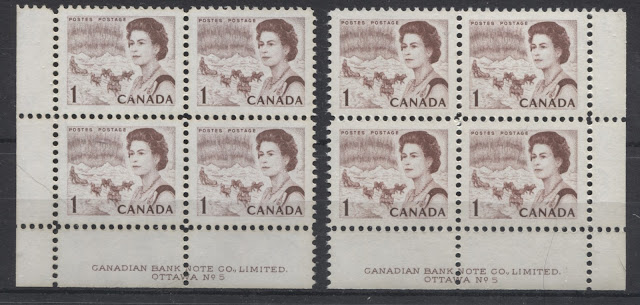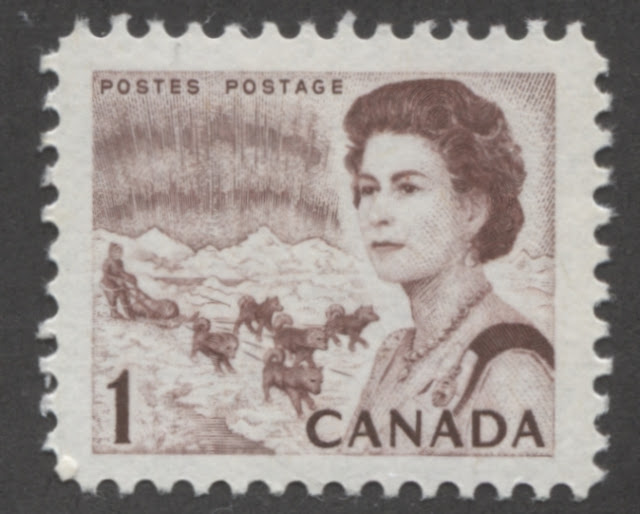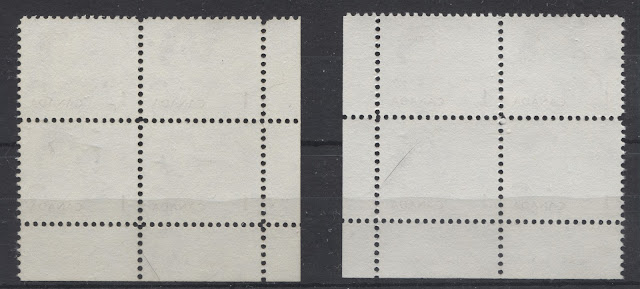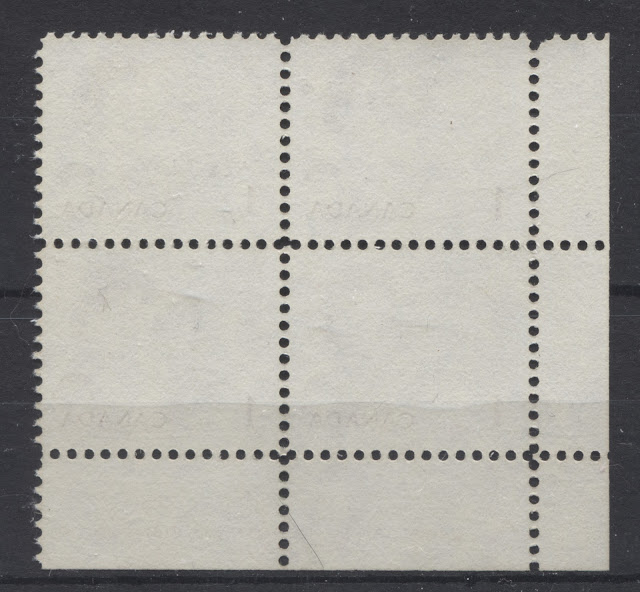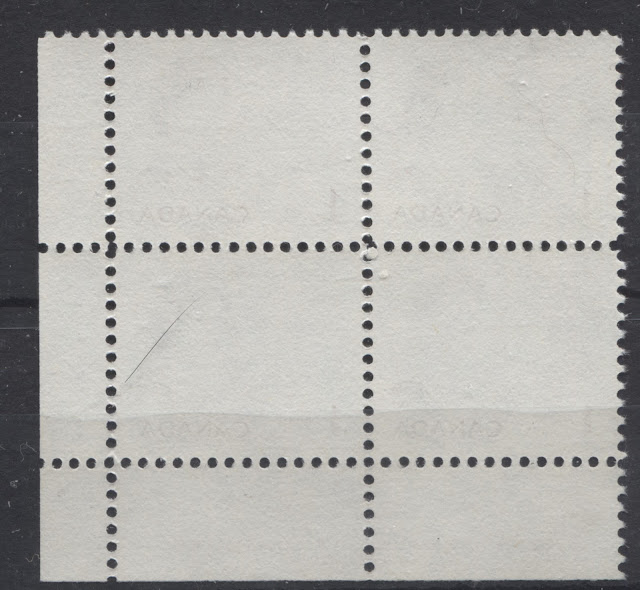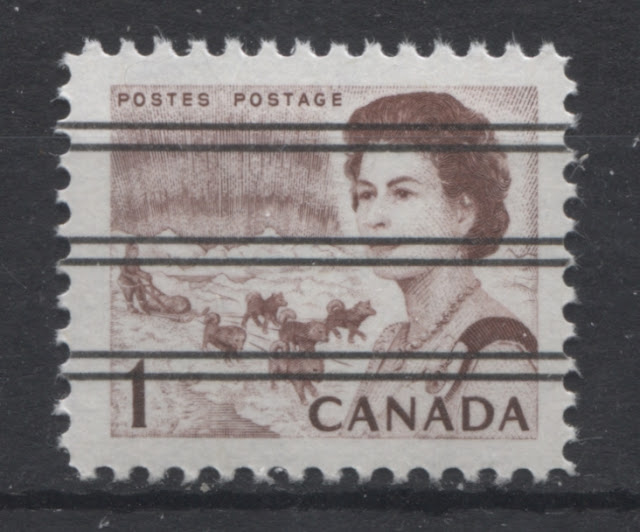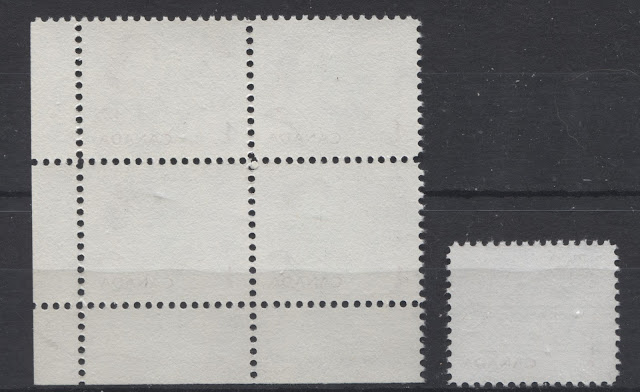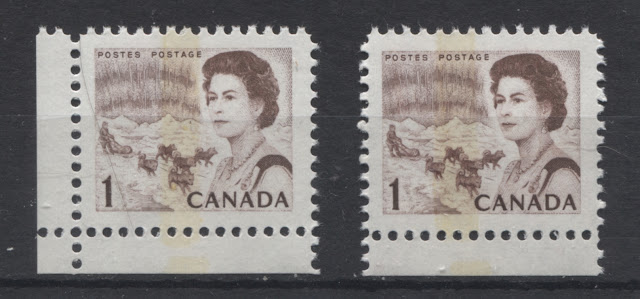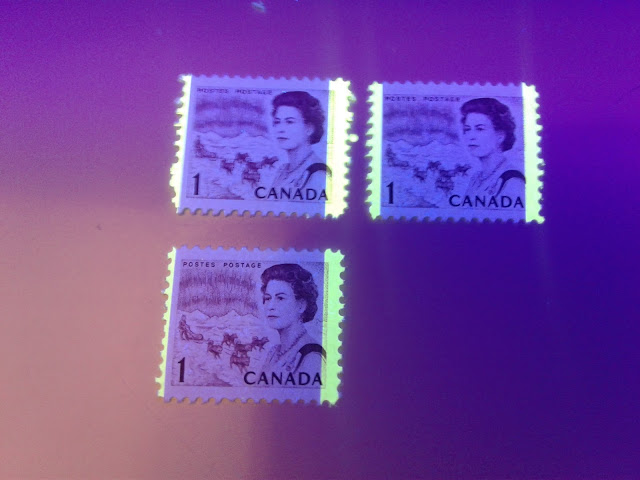Today, I delve into the PVA gum printings of the 1c Northern Lights and Dogsled sheet stamps. According to Unitrade, the first time these appeared was in November 1971, with the general tagged stamps, and then in December 1971, the untagged sheet stamps were issued. Finally, in January 1972, the stamps with Winnipeg centre bar tagging were issued.
This all raises a few questions, which may never be adequately answered:
The photograph below shows all three types:
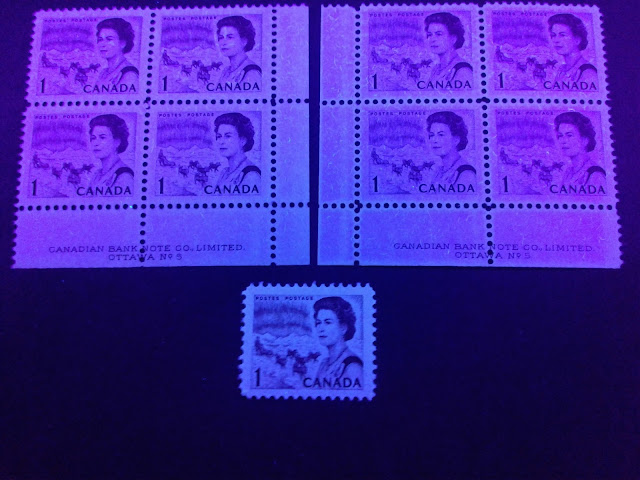
The first paper is shown at the top left, the second at top right and the third on the bottom. The differences between the first two types do not show up well in a photograph, but the difference between the third and the first or second, shows up quite readily.
The block on the left is a perfect match to Gibbons's chocolate. The block on the right is a perfect match to Gibbons's reddish brown.
The white satin gum is shown on the right, while the off-white cream gum is shown on the left. The difference is easily overlooked, but if you compare them side by side, they are quire distinct. I am not sure if the sheen differences will show up here, but here is a high resolution scan of the off-white gum:
and here is the white gum:
Papers
I have found four different papers on these stamps:
Shades
In my examination of all the general tagged stamps in my stock, I have encountered three shades, one of which is extremely distinct, and the reddish of the shades on this value. The other two are close to one another and easily overlooked if one is not paying very close attention:
The left stamp is the deep chocolate shade that we saw on the Winnipeg tagged stamp, The centre stamp is similar to the reddish brown of some of the untagged stamps, but is just a touch brighter. The right stamp is a perfect match to Gibbons's deep brown, which is similar to what we see on some of the dextrose gum printings from plate 4.
Under UV light, the inks appear as deeper versions of themselves, so they are non-transformative.
Gum
There appear to be two different types of gum on these stamps:
Appearance of the Tagging
All of the tagging that I have seen on all the stamps that I have examined is 4 mm wide, and the horizontal spacing between tag bars is 21 mm. There are 11 bars per sheet, all applied to the outer edges of the pane at right and left, as well as down the perforations between the stamps. Occasionally, the tagging is found so badly shifted as to produce either centre bar (G1aC) or right bar (G1aR) varieties. Ken Rose, in his handbook dealing with tagging errors on Canadian stamps, lists both types on this stamp, but he only lists them in used condition.
While I have not found any spacing or size variations in the tagging, I have found two different colours of tagging under UV light: bright yellow and very pale green. The picture below shows both types:
The upper left stamp shows the bright yellow tagging, while the stamp at the bottom shows the very pale green tagging. Generally, it appears that the yellow tagging is the later version, given that the colour is very close to what we see on the subsequent 1973-78 Caricature stamps. The gum on these is the thicker, shiner PVA and the colour is the reddish of the brown shades.
It appears that the tagging bars may run continuously down the length of the post office sheet from one pane to the next, as I have not seen any instances of blocks in which one tagging bar ends, while the next one begins.
Bringing it All Together
Although I have identified three shades, four paper types, two gum types and two tagging types, it is unlikely that every variety exists in combination with all the others. Specifically, the reddish brown stamp with the semi-gloss gum and deep yellow tagging seems to exist with only 1 paper type. But the others may exist with each of the varieties. So it would seem that there could be as many as 2 x 3 + 1 = 7 collectible varieties. All of the blocks, as with all tagged stamps are blank, and can be collected in up to 12 positions, so that the maximum number of collectible blocks is somewhere in the neighbourhood of 84 blocks.
So in conclusion, although there is not nearly as much scope offered with the PVA gum stamps as those with dextrose gum, there is still a great deal more than what the Unitrade listings would suggest. This concludes my discussion of the sheet stamps of this value. My next post will cover the perf. 12 CBN booklet stamps and the perf. 10 BABN booklet stamps.
This all raises a few questions, which may never be adequately answered:
- Why were the Winnipeg Tagged stamps issued at all, when the general tagged stamps were already available 2 months before?
- Why are there no OP-4 tagged stamps? All the GT-2 stamps seem to be OP-2, yet the general consensus among specialists is that OP-4 taggant was used first and abandoned when it became clear that it was unstable. Yet the lack of OP-4 stamps on this issue suggests that the situation may have been more complicated than this.
The answer to the first question may be that the equipment in operation in Winnipeg was still the old Sefcan machinery and that these required Winnipeg tagging to operate, until new machines that could read the OP-2 tagging were installed in Winnipeg sorting stations. On the second point, it would appear that OP-2 was used first, with OP-4 being an experimental taggant that was abandoned after it was discovered to be wholly unsuitable. After it was abandoned, the use of OP-2 resumed.
All of the stamps were printed from plate 5, although the plate inscriptions were trimmed off of all the tagged panes. Although these stamps are less complicated than the stamps with Dextrose gum, there are still some interesting varieties to be found, as we shall see, and the full extent of them provides quite a bit more scope than just the four basic listings in Unitrade.
Before I get into a discussion of the specific stamps, I had promised to discuss the differences between the paper of the PVA gum printings, and the paper used on the printings with dextrose gum. There are important differences between the papers used on these two groups of printings that will enable you to distinguish the stamps, even when they have no gum, as with used stamps.
Like the paper used for the dextrose gum printings, the paper tends to be vertical wove. However, if you look at the back of the stamp, you will never see any trace of ribbing. If you look at the printed surface under 10x magnification, you will be able to see a little surface porosity, but not too much. At the same time, the paper does not have a highly finished look, being smooth, but not burnished in the way that some of the earlier papers are. At the same time, it is not as porous as the paper used for the plate 3 and plate 4 printings. If you hold stamps or plate blocks printed on this paper up to a strong light and look carefully, you will see fine vertical striations running through the paper from top to bottom. You will not see these on any of the papers used for the dextrose gum printings. The paper used for the PVA gum printings is also white when viewed against a white background, whereas the paper for the dextrose gum printings always appears creamy and off-white by comparison.
However, the appearance of the paper under UV light is what will likely be your go-to characteristic, as it is completely different from the papers used to print the stamps with dextrose gum.
Unitrade lists only one paper type for the PVA gum stamps: low fluorescent flecked. In reality though, there are two broad paper types, with each type having several sub-types:
- A low fluorescent paper in which the paper appears low fluorescent overall, and does not appear flecked. Upon close examination with a 10x loupe under UV light, some fibres are indeed visible, but they are the same brightness as the overall paper, so that they disappear into the overall fluorescence of the paper. The colour of this paper under my UV light is generally a light bluish white. But other colours are possible, such as violet, bluish etc.
- A dull fluorescent paper that contains fluorescent fibres that vary from low fluorescent in brightness, all the way up to hibrite. The composition and concentration of these fibres is such that the paper overall appears low fluorescent, and indeed this is what Unitrade refers to as LF or LF-fl paper. The colour of the paper under UV can vary from greyish white, to light violet, through bluish violet and finally to light blue.
The photographs below show both these types of paper:
This first picture shows the first type of paper on the bottom single stamp, and the second type is shown on the two blocks. The fluorescent fibres do not show up too well in this picture, but show up very clearly in the picture below of a corner of a sheet of the stamp with Winnipeg cbar tag:
You can see the fluorescent fibres clearly in the selvage at the right, as well as in the margins of the stamps.
Although, you will come across examples of stamps with dextrose gum that are printed on paper with fluorescent fibres, they generally will not contain the sheer depth and brightness of fibres that these stamps will. In my nomenclature to describe fluorescence, I generally distinguish between 7 levels of concentration in a stamp, as follows:
- 1-2 fibres: literally 1 or 2 fibres across the entire surface of the stamp.
- Very few: anywhere from 3 to 10 fibres across the entire surface of the stamp.
- Very sparse: a very light sprinkling of fibres across the entire stamp surface. Gaps between fibres are as large as 3-5 mm.
- Sparse: a light sprinkling of fibres across the entire stamp surface. Gaps between fibres are smaller: 1-2 mm.
- Low density: an even distribution of fibres across the stamp surface. Gaps between fibres are generally no more than 1 mm.
- Medium density: a heavier distribution of fibres in which the fibres overlap and the largest white spaces are no more than 1/4 to 1/2 mm.
- High density: the fibres are so dense and close together that it appears at first as if there are no fibres, but one even fluorescence level. It is only after examination with a 10x loupe that it becomes apparent that there are actually fluorescent fibres in the paper.
Levels 6 and 7 generally do not occur on this issue, and will not be encountered until the 1970's with the paper manufactured and supplied by Abitibi-Price. Most of the dextrose gum printings exhibit levels 1-4, but generally not 5. The brightness of the fibres in the paper, will not usually be brighter than high fluorescent (HF), with most being either low fluorescent (LF) or medium fluorescent (MF). Very seldom will you see HB fibres in the paper, and if you do, it will not be more than 1 or 2 fibres. With the PVA gum printings, the second paper above exhibits the low density (level 5) of fibres. The brightness of these fibres varies from low fluorescent to highbrite (HB), with a large number of hibrite fibres being present. So in conclusion, the papers used for the PVA gum stamps are very distinct and with experience, sorting used stamps out should not be too difficult.
I will now discuss each of the major groups of PVA gum stamps:
- Untagged
- Untagged precancelled.
- Winnipeg tagged
- General tagged
Untagged Sheet Stamps: Unitrade #454iii
Unfortunately, I do not have a great deal of untagged stamps to work with at the moment. However, I do have enough to be able to comment on and illustrate some shade differences, as well as a very subtle difference in the PVA gum that could be very easily overlooked.
Papers
I have so far found three different papers on the untagged stamps:
- Dull fluorescent violet grey, with a low density concentration of dull fluorescent fibres, and sparse concentrations of low, medium and high fluorescent fibres.
- Dull fluorescent grey, with a low density concentration of dull fluorescent fibres, and sparse concentrations of low, medium and high fluorescent fibres.
- Low fluorescent bluish white, with a sparse concentration of low florescent fibres, and a very sparse concentration of medium fluorescent fibres.
The photograph below shows all three types:

The first paper is shown at the top left, the second at top right and the third on the bottom. The differences between the first two types do not show up well in a photograph, but the difference between the third and the first or second, shows up quite readily.
Shades
So far I have seen three distinct shades of brown on this stamp that are quite different from the shades seen on the early dextrose gum stamps. Two are very similar to one another, while the third is a very distinct shade of brown, containing no reddish undertone, but no blackish undertone either:
The block on the left is a perfect match to Gibbons's chocolate. The block on the right is a perfect match to Gibbons's reddish brown.
This stamp is printed in a slightly deeper shade than the reddish brown above. In fact, it is an almost perfect blend of the chocolate and reddish brown shades.
These three shades are closest to those found on the dextrose gum printings on the hibrite paper, but are generally quite different from the other dextrose gum printings. Under ultraviolet light, the colours are merely deeper versions of brown, but are not essentially different from what they are under normal light. Therefore the inks used are non-transformative.
Gum
Upon close examination of the stamps, it will become apparent that there are actually two different types of PVA gum used in printing these stamps:
- A very white gum that has a satin sheen.
- An off-white gum that has a duller and thinner appearance, an eggshell sheen.
A side-by side comparison scan showing the two types of gum together follows, along with individual high resolution scans of each type:
The white satin gum is shown on the right, while the off-white cream gum is shown on the left. The difference is easily overlooked, but if you compare them side by side, they are quire distinct. I am not sure if the sheen differences will show up here, but here is a high resolution scan of the off-white gum:
and here is the white gum:
Apart from an slight difference in thickness (the white gum appears slightly thicker), the differences are not too obvious from a scan. I see my cat Viktor has left little bits of his coat all over my scanner!! Sorry about that, but he sheds a lot, and even with several wipe-downs a day, it is hard to get them all.
Perforations
The only perforation I have found on the stamps I have looked at is 11.85 x 11.85. I do not know whether or not the 11.95 gauge was still in use at this point, but it does not appear to have been. However, if I find 11.95 or compounds on the other types of stamps, then I will know that it should also exist on these stamps as well.
Bringing it All Together
I have found three shades, three paper types and two types of gum. I do not know if every shade exists with both gum types and all three paper types. However, as there are likely other paper types that I have not found yet, I will assume that for purposes of determining how many collectible varieties there are, I will assume that there are 3 x 3 x 2 = 18 collectible varieties. The only plate blocks that exist are plate 5, as well as blank blocks that can be found in 12 positions, with different selvage widths. So the number of collectible blocks should be at least 16 x 12 = 192 blocks.
Bringing it All Together
I have found three shades, three paper types and two types of gum. I do not know if every shade exists with both gum types and all three paper types. However, as there are likely other paper types that I have not found yet, I will assume that for purposes of determining how many collectible varieties there are, I will assume that there are 3 x 3 x 2 = 18 collectible varieties. The only plate blocks that exist are plate 5, as well as blank blocks that can be found in 12 positions, with different selvage widths. So the number of collectible blocks should be at least 16 x 12 = 192 blocks.
Untagged Precancelled Stamps: Unitrade #454xxi
Paper
The paper that I have seen so far on this stamp is a dull fluorescent bluish white paper under UV light, that shows a low density concentration of dull fluorescent fibres and very sparse concentrations of low, medium and high fluorescent fibres. There are both fewer fibres in the paper of these stamps, and the fibres are not as bright as on the untagged stamps.
Shade
So far, I have only seen this stamp printed in the reddish brown shade, as shown below:
Gum
On these stamps, I have come across a third type of PVA gum. This one is very white, but is much shinier than the other two. The sheen on this is actually more of a semi-gloss, rather than a satin sheen. The white is even whiter than the white gum with the satin sheen. Here is a high resolution scan showing the differences between the earlier satin gum and the semi-gloss white gum:
The very white gum of the precancelled stamp is shown on the right. Here is a scan showing it next to the cream eggshell gum:
The difference between these two gums is even more stark, to the point where I just can't see how anyone would think they are the same.
Perforation
Again, as with the other untagged stamps, all of the stamps that I examined were perf. 11.85.
Bringing It All Together
Here I have only found a single collectible variety so far. Generally, the precancels are collected as warning strips when they are collected in multiples, and there are two positions, right and left. So the maximum number of collectible strips is 2. This is likely the simplest of all the sub-types of this very complicated stamp.
Paper
The paper that I have seen so far on this stamp is a dull fluorescent bluish white paper under UV light, that shows a low density concentration of dull fluorescent fibres and very sparse concentrations of low, medium and high fluorescent fibres. There are both fewer fibres in the paper of these stamps, and the fibres are not as bright as on the untagged stamps.
Shade
So far, I have only seen this stamp printed in the reddish brown shade, as shown below:
Gum
On these stamps, I have come across a third type of PVA gum. This one is very white, but is much shinier than the other two. The sheen on this is actually more of a semi-gloss, rather than a satin sheen. The white is even whiter than the white gum with the satin sheen. Here is a high resolution scan showing the differences between the earlier satin gum and the semi-gloss white gum:
The very white gum of the precancelled stamp is shown on the right. Here is a scan showing it next to the cream eggshell gum:
The difference between these two gums is even more stark, to the point where I just can't see how anyone would think they are the same.
Perforation
Again, as with the other untagged stamps, all of the stamps that I examined were perf. 11.85.
Bringing It All Together
Here I have only found a single collectible variety so far. Generally, the precancels are collected as warning strips when they are collected in multiples, and there are two positions, right and left. So the maximum number of collectible strips is 2. This is likely the simplest of all the sub-types of this very complicated stamp.
Winnipeg Tagged Stamps: Unitrade #454piv
Paper
Two papers seem to exist on these stamps:
Shades
Gum
The gum on all the stamps I have examined is the second type of white PVA gum with a satin sheen.
Perforation
Again, the perforation on all the tagged stamps that I have looked at is still 11.85. I have not yet found any instance of the 11.95 gauge.
Appearance of the Tagging

Paper
Two papers seem to exist on these stamps:
- Dull fluorescent violet grey paper under UV, showing sparse concentrations of low, medium and high fluorescent fibres, that give it a low fluorescent appearance overall. Some stamps may also have 1 or 2 hibrite fibres visible.
- A similar paper, except that the colour under UV is grey, instead of violet grey.
Shades
I have seen two shades of these tagged stamps that differ from the chocolate and reddish brown shades seen on the untagged stamps. The stamp on the left is a deeper version of the chocolate shade as compared to the chocolate of the untagged stamps. The stamp on the right is a deeper shade of the reddish brown as compared with the untagged stamps.
Under UV light, the colours simply appear as deeper versions of what is normally visible under normal light. Therefore the inks are non-transformative.
Gum
The gum on all the stamps I have examined is the second type of white PVA gum with a satin sheen.
Perforation
Again, the perforation on all the tagged stamps that I have looked at is still 11.85. I have not yet found any instance of the 11.95 gauge.
Appearance of the Tagging

The above image is the lower right corner of a full sheet of the Winnipeg tagged stamps. As you can see, the colour of the tagging under UV is a pale greenish yellow, as we saw on some examples of the stamp with dextrose gum. I have not come across any examples in which the tagging shows any bluish or bluish white reaction, as we had seen on some of the earlier 2-bar Winnipeg tags. This suggests that the bluish tagging is an earlier form, from before 1971 that utilized a taggant that had a slightly different chemical formula from the one used here.
The tagging bars are 4 mm wide and the space between the bars on the sheet is 20.5 mm all the way along the sheet. A full sheet contains 10 bars.
The bars do not run continuously down the full sheet, but stop just beyond the end of one pane, before a second series of bars covers the pane below. You can always identify corner blocks from the junction of the upper and lower panes by the fact that you will see one bar end and another begin in the lower selvage.
Bringing it All Together
I have found two paper types and two shades, though only one gum type. This means that there could be up to four collectible varieties, assuming that every paper type exists with every shade. Like all of the tagged stamps, blocks are all blank and can be collected in the usual 12 positions. This suggests that there are up to 48 different collectible blocks of this stamp.
General Tagged Stamps: Unitrade #454piii
The tagging bars are 4 mm wide and the space between the bars on the sheet is 20.5 mm all the way along the sheet. A full sheet contains 10 bars.
The bars do not run continuously down the full sheet, but stop just beyond the end of one pane, before a second series of bars covers the pane below. You can always identify corner blocks from the junction of the upper and lower panes by the fact that you will see one bar end and another begin in the lower selvage.
Bringing it All Together
I have found two paper types and two shades, though only one gum type. This means that there could be up to four collectible varieties, assuming that every paper type exists with every shade. Like all of the tagged stamps, blocks are all blank and can be collected in the usual 12 positions. This suggests that there are up to 48 different collectible blocks of this stamp.
General Tagged Stamps: Unitrade #454piii
I have found four different papers on these stamps:
- Dull fluorescent greyish ivory under UV, with a sparse concentration of dull fluorescent fibres, and very sparse concentrations of low and medium fluorescent fibres.
- Dull fluorescent light blue under UV, with a low density concentration of dull fluorescent fibres, and sparse concentrations of low, and medium fluorescent fibres, a very sparse concentration of high fluorescent fibres, and very few brownish woodpulp fibres visible in the paper.
- Dull fluorescent violet grey under UV, with a sparse concentration of low and medium fluorescent fibres.
- Dull fluorescent violet grey under UV, with a low density concentration of dull fluorescent fibres, sparse concentrations of low and medium fluorescent fibres and a very sparse concentration of high fluorescent fibres.
There may be other varieties, and I will add additional entries for any that I come across as I come across them. The second type introduces a new phenomenon with papers that we do not see until the early 1970's: brownish woodpulp fibres. These are brownish flecks in the paper that are invisible until the paper is viewed under UV light. Paper containing these flecks can generally be regarded as being from the very last printings made in late 1972 or early 1973.
Shades
In my examination of all the general tagged stamps in my stock, I have encountered three shades, one of which is extremely distinct, and the reddish of the shades on this value. The other two are close to one another and easily overlooked if one is not paying very close attention:
The left stamp is the deep chocolate shade that we saw on the Winnipeg tagged stamp, The centre stamp is similar to the reddish brown of some of the untagged stamps, but is just a touch brighter. The right stamp is a perfect match to Gibbons's deep brown, which is similar to what we see on some of the dextrose gum printings from plate 4.
Under UV light, the inks appear as deeper versions of themselves, so they are non-transformative.
Gum
There appear to be two different types of gum on these stamps:
- The second white type with satin sheen, which seems to occur on the deep chocolate and deep brown shades.
- The third white type with the semi-gloss sheen, which seems to occur only on the reddish brown stamp with the deep yellow tagging.
One defining characteristic of the paper with the semi-gloss gum that stands out is that the perforations are often blind and not fully punched out as is the case with the centre stamp in the previous scan. I believe these are generally the last printings made just before the 1c John A. Macdonald stamp of the Caricature issue replaced it in October 1973.
Perforation
All of the stamps that I examined with general tagging are perf. 11.85. Therefore, I believe that the 11.95 machines had been retired by the time these printings were made. Of course, it is possible that examples perf. 11.95 and compound with 11.85 do exist, but it seems unlikely, as I generally would have found one by now in the stamps I looked at. So you should be aware that they could exist.
Appearance of the Tagging
All of the tagging that I have seen on all the stamps that I have examined is 4 mm wide, and the horizontal spacing between tag bars is 21 mm. There are 11 bars per sheet, all applied to the outer edges of the pane at right and left, as well as down the perforations between the stamps. Occasionally, the tagging is found so badly shifted as to produce either centre bar (G1aC) or right bar (G1aR) varieties. Ken Rose, in his handbook dealing with tagging errors on Canadian stamps, lists both types on this stamp, but he only lists them in used condition.
While I have not found any spacing or size variations in the tagging, I have found two different colours of tagging under UV light: bright yellow and very pale green. The picture below shows both types:
The upper left stamp shows the bright yellow tagging, while the stamp at the bottom shows the very pale green tagging. Generally, it appears that the yellow tagging is the later version, given that the colour is very close to what we see on the subsequent 1973-78 Caricature stamps. The gum on these is the thicker, shiner PVA and the colour is the reddish of the brown shades.
It appears that the tagging bars may run continuously down the length of the post office sheet from one pane to the next, as I have not seen any instances of blocks in which one tagging bar ends, while the next one begins.
Bringing it All Together
Although I have identified three shades, four paper types, two gum types and two tagging types, it is unlikely that every variety exists in combination with all the others. Specifically, the reddish brown stamp with the semi-gloss gum and deep yellow tagging seems to exist with only 1 paper type. But the others may exist with each of the varieties. So it would seem that there could be as many as 2 x 3 + 1 = 7 collectible varieties. All of the blocks, as with all tagged stamps are blank, and can be collected in up to 12 positions, so that the maximum number of collectible blocks is somewhere in the neighbourhood of 84 blocks.
So in conclusion, although there is not nearly as much scope offered with the PVA gum stamps as those with dextrose gum, there is still a great deal more than what the Unitrade listings would suggest. This concludes my discussion of the sheet stamps of this value. My next post will cover the perf. 12 CBN booklet stamps and the perf. 10 BABN booklet stamps.


